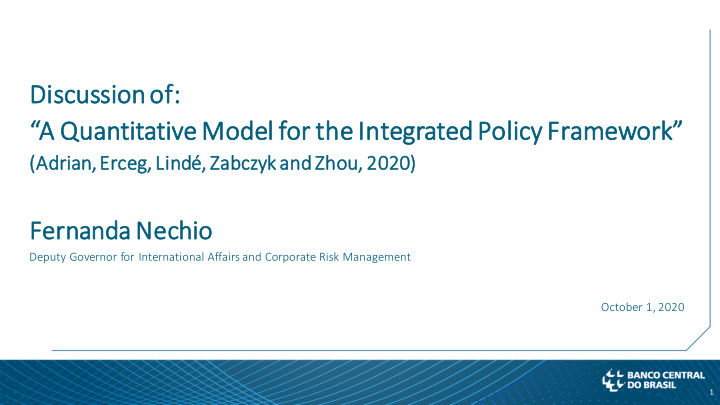



Discussionof of: : “A “A Quanti titati tive Model el for th the Integ egrated ed Policy cy Fra ramework rk” (Adrian, Erceg eg, Lindé dé, Zabczyk an andZhou, 2 2020 020) Fernanda N Nechio Deputy Governor for International Affairs and Corporate Risk Management October 1, 2020 1
This ispaper er New Keynesian model to evaluate and quantify the use of multiple policy tools EMEs having to resort to procyclical policies in face of shocks FXI and CFM may improve policy tradeoffs for countries with inflation expectations not well anchored, FX mismatch, and subject to capital outflows and FX pressures
Intu tuiti tionan and main ainresu sultsin in on one slid ide
Main ain m mod odel i l ingredie ients New Keynesian small open economy model (Galí and Monacelli, 2005) + Local currency pricing (and alternatives) + Adaptive inflation expectations to account for imperfect credibility + Wage indexation with full pass-through from exchange rates + Incomplete markets with agents borrowing in foreign-currency denominated bonds + Nonlinear UIP risk premium where return depends on foreign liabilities + Nonlinear spread that depends on FX + ELB + FXI and CFM rules
Indexation a and c cred edibility Phillips curve: “This persistence may be interpreted as dynamic indexation… Our preferred interpretation … highlights the role of imperfect central bank credibility” Link between credibility and indexation not so straightforward Modelling CB credibility (DSGE literature) Credible CBs may operate under wage and price indexation Coenen, Karadi, Schmidt, Warne (2019) ECB Working Paper 2200
Pa Pass-through Wage inflation: Empirical evidence? Implications of this channel to results? Debt service: Empirical evidence of full pass-through? Implications of this channel to results? Effects of economic conditions on pass-through Empirical evidence suggest a decline in pass-through in emerging economies
FXI a I and C CFM r rules es Foreign exchange intervention: Central bank responds to movements “off relative to fundamentals”. Intervention reduces risk premium directly Fixed FX regime is a special case Capital flow intervention: Intervention affects FX directly Inflows versus outflows Implementation timeframe Exogeneous rules with no costs associated with either policy No feedback effects!
Addit itio ional c l com omments Focus on AE versus EME or high-debt versus low-debt EME? Aggressive TR discussion missing cost-benefit analysis, hence, cannot infer on risks of de-anchoring nor discussion about intervention rules Borrowing in hard currency only Decomposing net foreign liabilities No role for financial flows on net foreign liability Implications for commodity exporters Effects of exchange rate on intermediate inputs imports What are the drivers of the differences between AE and EME IRFs? Calibration (PC, pass-through assumptions, shocks), model assumptions
Covid id-19: 19: Risk s shoc ock t to E EME, y yet c cou ountercyclic ical p al polic olicies Interest Rates in EME** 9 10%-90% 8 Interquantile 7 Median 6 Mean 5 4 3 2 1 0 Jan-20 Feb-20 Mar-20 Apr-20 May-20 Jun-20 Jul-20 Aug-20 Sep-20 ** Composite of currencies of Brazil, Mexico, Argentina, Chile, Colombia, Peru, China, Hong Kong, Taiwan, India, Indonesia, South Korea, Malaysia, Singapore, Thailand, Philippines, Russia, Turkey, Czech Republic, Bulgaria, Romania, Hungary, Poland, and South Africa.
To conclude... To .. Very nice paper! Timely discussion and interesting implications Several suggestions and model variations to understand result drivers, empirical properties and allow for cost-benefit analysis Heterogeneity across emerging economies is key!
Recommend
More recommend